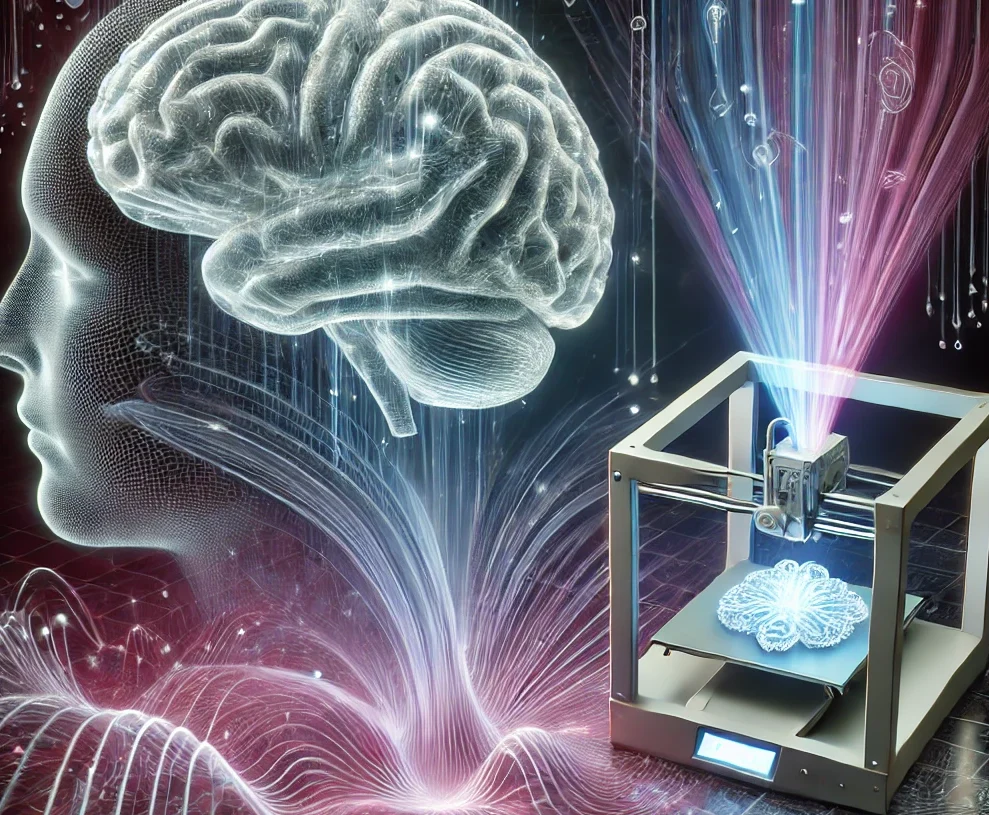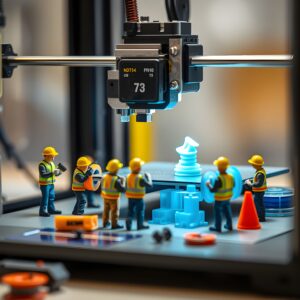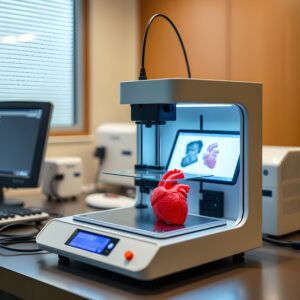Mapping the Mind: OpenBCI’s Revolutionary Approach to Converting Brainwaves into 3D Printed Reality

The intersection of technology and neuroscience has led to some of the most exciting developments in modern science. One company, OpenBCI, is at the forefront of this revolution. Known for their pioneering work in brain-computer interface (BCI) technology, OpenBCI is now taking the concept of BCI a step further by introducing a way to convert brainwaves into 3D-printed objects. This remarkable feat has the potential to redefine the relationship between our minds and the physical world, opening new avenues for advancements in healthcare, art, design, and more.
This article takes a deep dive into OpenBCI’s transformative technology, exploring how the company is bridging the gap between brain activity and physical reality. By using state-of-the-art tools and cutting-edge algorithms, OpenBCI is making the impossible possible. We will examine the process in detail, from how brainwaves are captured and analyzed to how they are used to create 3D objects. Along the way, we will explore the diverse applications and challenges associated with this groundbreaking technology.
Understanding Brain-Computer Interfaces (BCIs)
Brain-computer interfaces (BCIs) represent a technology that enables direct communication between the brain and an external device. For decades, BCIs have been utilized to assist individuals with mobility impairments or those who are unable to communicate through traditional means. At their core, BCIs work by detecting electrical signals produced by the brain, also known as brainwaves. These signals are typically measured through electrodes placed on the scalp or, in more advanced cases, implanted within the brain itself.
The technology works by reading electrical activity generated by neurons. The brain’s neurons communicate by sending electrical impulses across synapses, and this electrical activity can be detected and measured. These impulses are categorized into different types of brainwaves, each associated with a specific mental state. For example, alpha waves are linked to relaxation, while beta waves correspond to active thinking and concentration.
The challenge, however, lies in decoding these signals. Unlike other forms of data input, such as mouse clicks or keyboard strokes, the brain’s electrical impulses are not as straightforward to interpret. They are noisy and often hard to distinguish from other electrical signals in the body. In the early days of BCI research, it was primarily used in simple applications like controlling robotic arms or typing on a computer screen using thought alone. However, as the technology progressed, BCIs have become much more sophisticated.
At its core, OpenBCI’s mission is to make BCIs more accurate and accessible to a wider audience. The company has developed EEG (electroencephalography) headsets that are capable of picking up even the faintest brainwave signals, which are then processed through sophisticated software systems. The primary innovation OpenBCI has introduced is its ability to convert brainwave data not just into commands for external devices, but into something physical—3D-printed objects.
OpenBCI’s Breakthrough in Brainwave-to-3D-Printing Technology
The brainwave-to-3D-printing technology developed by OpenBCI is a stunning example of how neural data can be converted into something tangible. The process begins when a user wears one of OpenBCI’s EEG headsets, which are designed to measure brainwave activity. These headsets are equipped with electrodes that sit on the scalp and capture the electrical signals produced by the brain. The EEG headsets are highly sensitive and capable of capturing even the smallest fluctuations in brain activity.
The captured signals are then transmitted to a computer, where they are processed by specialized software designed to interpret brainwaves. These signals are then decoded into actionable data using advanced algorithms and machine learning models. The software works by analyzing patterns in the brainwave data to identify the user’s intentions. For instance, a person thinking about a geometric shape or a specific object will produce distinctive brainwave patterns. The system can recognize these patterns and translate them into digital data that a 3D printer can understand.
This data is typically transformed into a digital file format, such as an STL (stereolithography) file, which is the standard format for 3D printing. The STL file represents a 3D object in a way that can be interpreted by most 3D printers. Once the file is ready, it is sent to a 3D printer, which uses materials like plastic, resin, or metal to build the object layer by layer. What makes OpenBCI’s approach truly revolutionary is that the entire process—brainwave capture, signal processing, data conversion, and 3D printing—is happening in real-time.
The real challenge lies in the accuracy and precision of translating brainwaves into 3D models. Brain activity is highly complex and varies from person to person, making it difficult to create a universal system for interpretation. However, OpenBCI has invested significant resources in developing algorithms that can filter out noise from the brainwave signals and focus on the relevant information. This makes it possible to translate thoughts into 3D objects with remarkable accuracy.
The Process: From Brainwaves to 3D Models
1. Brainwave Capture
The first step in OpenBCI’s brainwave-to-3D-printing process is capturing the brain’s electrical signals. This is accomplished using EEG headsets designed specifically for brainwave detection. The headsets are equipped with a series of electrodes that make contact with the scalp. These electrodes detect the electrical signals generated by neurons as they communicate with each other. The technology is non-invasive, meaning it does not require surgery or implantation of devices into the brain. Instead, it relies on the natural electrical activity of the brain, which can be picked up through the scalp.
OpenBCI’s EEG headsets are particularly advanced, offering high levels of sensitivity and precision in detecting brainwave patterns. The electrodes used are arranged in such a way as to cover different regions of the brain, ensuring that the data collected provides a holistic view of brain activity. Once the brainwaves are captured, the data is sent to a computer or processing unit where it can be analyzed.
One of the most challenging aspects of brainwave capture is filtering out interference from other electrical activity. For example, electrical signals from the muscles, eyes, and even external electronic devices can disrupt the brainwave data. OpenBCI’s headsets include advanced signal processing techniques that clean the data, ensuring that only the most relevant brainwave patterns are extracted for further analysis.
2. Signal Processing and Interpretation
Once the brainwave signals are captured, the next step is processing and interpretation. The raw signals are often messy, filled with noise from various sources. To make sense of the data, OpenBCI employs sophisticated signal processing algorithms that filter out irrelevant noise and focus on the relevant brainwave patterns. These algorithms are trained to recognize specific brainwave frequencies associated with different mental states, such as focus, relaxation, or creativity.
The processing system uses a combination of machine learning and neural networks to decode the data. These systems are trained on large datasets of brainwave patterns and learn to recognize patterns that correspond to particular thoughts or intentions. For example, if a user thinks about a square, the system might identify specific brainwave patterns associated with that thought. Over time, the system learns to become more accurate in interpreting these signals.
Another critical aspect of signal interpretation is understanding the context of the brainwave patterns. For example, when a person is concentrating, their brain produces high-frequency beta waves. When relaxed, alpha waves are more prominent. OpenBCI’s algorithms can detect these variations and use them to build a model of the user’s thoughts. This is crucial because thoughts are not static—they evolve continuously. OpenBCI’s technology must account for these changes in real-time to produce accurate results.
3. Data Conversion into Digital Models
Once the brainwave signals have been processed and interpreted, they are converted into digital data that can be understood by a 3D printer. This step is where the brainwave data transitions from an abstract signal to a concrete object. The decoded brainwave information is translated into a 3D model, typically in the form of an STL file, which is the standard file format used in 3D printing.
The conversion process involves taking the mental image or object that the user is thinking about and turning it into a digital representation. This is not as simple as just drawing a shape—the software must accurately interpret the user’s intent, which may involve complex geometry, textures, or even more abstract concepts. For example, if a user is imagining a specific object, the system must recognize not only the shape but also the details, such as size, proportions, and other characteristics.
Once the 3D model is created, it is prepared for printing. This step involves converting the model into a series of instructions (G-code) that the 3D printer can follow. These instructions tell the printer how to build the object layer by layer, specifying things like material type, temperature, and print speed. The digital model is now ready to be sent to the 3D printer.
4. 3D Printing the Object
The final step in the process is 3D printing the object. Once the data is converted into a file that the printer can read, the 3D printer begins the process of building the object. The printer uses a variety of materials, including plastics, resins, and metals, to construct the object layer by layer. Each layer of material is carefully deposited, and the printer follows the instructions given by the software to create the object with incredible precision.
The 3D printing process is highly customizable. Depending on the material used and the printer’s capabilities, objects can be printed with different textures, finishes, and even internal structures. This means that the objects created from brainwaves are not only functional but can also be designed with aesthetic considerations in mind.
Applications of Brainwave-Driven 3D Printing
The potential applications for OpenBCI’s brainwave-driven 3D printing technology are vast and multifaceted. This breakthrough technology could revolutionize numerous industries, offering innovative solutions for both medical and non-medical fields. Below, we explore some of the most exciting applications of this technology.
Medical Advancements
One of the most promising applications of brainwave-driven 3D printing lies in healthcare. Custom medical devices, such as prosthetics, could be designed and manufactured more efficiently and accurately by directly interpreting a patient’s thoughts. For example, a person with a limb loss could think about the shape and functionality of their prosthetic, and OpenBCI’s technology would translate those thoughts into a 3D model. The result would be a personalized prosthetic, tailored to the individual’s needs.
This method of creating medical devices would not only be more efficient but also more accessible. Rather than relying on a long process of design, consultation, and trial-and-error fitting, patients could work directly with the technology to create their ideal device in real-time. This could also extend to implants, surgical tools, and other medical devices that require precise customization for each patient.
Assistive Technologies
For people with disabilities, brainwave-driven 3D printing could open up new possibilities for communication and independence. For example, individuals who are unable to speak due to paralysis or neurological conditions could use this technology to control devices, such as computers or speech-generating devices, with their thoughts. This would allow them to communicate in real-time, enhancing their quality of life and enabling greater autonomy.
Additionally, the technology could be used to create customized assistive devices that are tailored to the user’s needs. Whether it’s a wheelchair that can be controlled by thought or a specialized tool designed for a particular task, brainwave-to-3D-printing technology could significantly improve accessibility for people with various disabilities.
Creative and Artistic Expression
Brainwave-driven 3D printing could also revolutionize the world of art and design. Artists could create sculptures or interactive art installations using nothing but their thoughts. Instead of using physical tools like clay or paint, they could mentally design and sculpt 3D objects, refining their creations without ever touching a piece of material. This opens up new possibilities for artists to express themselves in ways that were previously impossible.
Moreover, the technology could be used to create intricate, highly personalized designs. Imagine a jewelry designer who can “think” about a piece of jewelry and have it immediately brought to life in 3D. The fusion of technology and creativity could lead to an entirely new genre of art and design.
Ethical Considerations and Challenges
As with any new technology, the implementation of brainwave-driven 3D printing raises several ethical considerations. One of the most significant concerns is privacy. The ability to interpret and record an individual’s thoughts brings with it potential risks of unauthorized access or misuse of personal data. For example, what happens if someone’s brainwave patterns, which are uniquely tied to their thoughts and intentions, fall into the wrong hands?
Additionally, there are concerns about the security of the data used in these processes. Since brainwaves can be decoded into digital information, it’s essential that stringent measures be taken to protect this data from hacking or other forms of exploitation.
Another key challenge lies in the accuracy and precision of the technology. The human brain is incredibly complex, and decoding its electrical activity with 100% accuracy is a difficult task. Brainwave patterns can vary from person to person, and even small differences in the way an individual thinks can result in errors or imprecision in the 3D printing process. As OpenBCI continues to refine its technology, it’s crucial that the company ensures the reliability and safety of the process.
The Future of OpenBCI and 3D Printing
The future of brainwave-driven 3D printing is incredibly exciting. As OpenBCI continues to push the boundaries of what’s possible, it’s likely that this technology will play a key role in the development of many new products and innovations. Brainwave-driven 3D printing could eventually become a commonplace tool in everything from home manufacturing to personalized medicine.
As the technology advances, it’s possible that we could see widespread adoption of mind-controlled systems that allow people to interact with the world in entirely new ways. Whether it’s designing custom products, controlling machines with thoughts, or creating new forms of art, the future is full of possibilities.
In the coming years, OpenBCI’s technology may even be integrated into everyday devices like smartphones and home automation systems, enabling a seamless blend between the digital and physical worlds. With continued research and development, this revolutionary technology could change the way we interact with our surroundings and each other.
A New Era of Innovation
OpenBCI’s revolutionary approach to converting brainwaves into 3D-printed objects has the potential to reshape industries and revolutionize human interaction with technology. While the challenges are significant, the possibilities are vast. From medical applications to creative expression, the ability to turn thoughts into physical objects could open up new frontiers in both science and art.
As research continues and the technology evolves, we can only imagine the new opportunities that will arise from the fusion of neuroscience and 3D printing. OpenBCI is paving the way for a future where our thoughts can shape the world around us, and the potential impact on society is immense.
Feel free to check out our other website at : machinepwr.com




